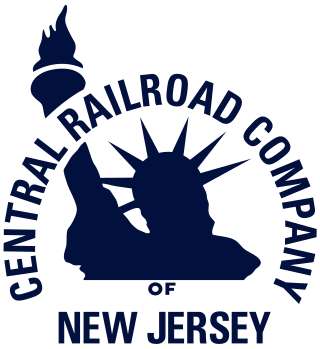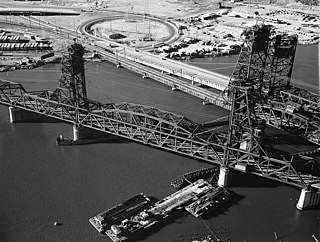
The Central Railroad of New Jersey, also known as the Jersey Central, Jersey Central Lines or New Jersey Central, was a Class I railroad with origins in the 1830s. It was absorbed into Conrail in April 1976 along with several other prominent bankrupt railroads of the Northeastern United States.

The Kearny Connection is a railroad junction in Kearny, New Jersey that allows passenger trains from New Jersey Transit's Morris and Essex Lines to enter/leave Amtrak's Northeast Corridor (NEC) and travel to and from New York Penn Station. The junction, which opened in 1996 and utilizes Swift Interlocking, is nearby the Sawtooth Bridges.

The New York Tunnel Extension is a combination of railroad tunnels and approaches from New Jersey and Long Island to Pennsylvania Station in Midtown Manhattan.

For the purposes of this article, the Jersey City area extends North to Edgewater, South to Bayonne and includes Kearny Junction and Harrison but not Newark. Many routes east of Newark are listed here.

The Manhattan Transfer station was a passenger transfer station in Harrison, New Jersey, east of Newark, 8.8 miles (14.2 km) west of New York Penn Station on the Pennsylvania Railroad (PRR) main line, now Amtrak's Northeast Corridor. It operated from 1910 to 1937 and consisted of two 1,100 feet (340 m) car-floor-level platforms, one on each side of the PRR line. It was also served by the Hudson and Manhattan Railroad. There were no pedestrian entrances or exits to the station, as its sole purpose was for passengers to change trains, or for trains to have their locomotives changed.
The United New Jersey Railroad and Canal Company (UNJ&CC) was a United States–based railroad company established in 1872. It was formed by the consolidation of three existing companies: the Camden and Amboy Railroad, Delaware and Raritan Canal Company, and New Jersey Rail Road and Transportation Company. The Camden and Amboy and New Jersey Rail Road were among the earliest North American railroads. The Pennsylvania Railroad leased the United New Jersey Railroad and Canal Company in 1872.

The Journal Square Transportation Center is a multi-modal transportation hub located on Magnolia Avenue and Kennedy Boulevard at Journal Square in Jersey City, New Jersey, United States. Owned and operated by the Port Authority of New York and New Jersey, the complex includes a ten-story tower, a retail plaza, a bus terminal, a two-level parking facility, and the Journal Square station of the PATH rail transit system. The underground station has a high ceiling and a mezzanine level connecting the platforms.

Paulus Hook is a community on the Hudson River waterfront in Jersey City, New Jersey. It is located one mile across the river from Manhattan. The name Hook comes from the Dutch word "hoeck", which translates to "point of land." This "point of land" has been described as an elevated area, the location of which today is bounded by Montgomery, Hudson, Dudley, and Van Vorst Streets.
Exchange Place is a district of Downtown Jersey City, New Jersey that is sometimes referred to as Wall Street West due to the concentration of financial companies that have offices there. The namesake is a square, about 200 feet long, at the foot of Montgomery Street at the waterfront of the Hudson River. This square was created by landfilling the shore at Paulus Hook, and has been a major transportation hub since the colonial era.

The Exchange Place station is a station on the Port Authority Trans–Hudson (PATH) rail system in the Paulus Hook neighborhood of Jersey City, Hudson County, New Jersey. The station is on the Newark–World Trade Center line between Newark Penn Station and World Trade Center all week and the Hoboken–World Trade Center line during the day on weekdays to service Hoboken Terminal. Exchange Place provides access to the Jersey City waterfront and a station on the Hudson–Bergen Light Rail, where connections are available to Bayonne and North Bergen.

The Central Railroad of New Jersey Terminal, also known as Communipaw Terminal and Jersey City Terminal, was the Central Railroad of New Jersey's waterfront passenger terminal in Jersey City, New Jersey. The terminal was built in 1889, replacing an earlier one that had been in use since 1864. It operated until April 30, 1967.

Pavonia Terminal was the Erie Railroad terminal on the Hudson River located in the Harsimus section of Jersey City, New Jersey. The station opened in 1861 and closed in 1958 when the Erie Railroad moved its passenger services to nearby Hoboken Terminal. The New York, Susquehanna and Western Railway also ran commuter trains from the terminal and various street cars, ferries and the underground Hudson and Manhattan Railroad serviced the station. The station was abandoned in 1958 and demolished in 1961. The site was eventually redeveloped into the Newport district in the late 20th century.

The North River Tunnels are a pair of rail tunnels that carry Amtrak and New Jersey Transit passenger lines under the Hudson River between Weehawken, New Jersey, and Pennsylvania Station in Manhattan, New York City, New York. Built between 1904 and 1908 by the Pennsylvania Railroad (PRR) to allow its trains to reach Manhattan, they opened for service in late 1910.

The Downtown Hudson Tubes are a pair of tunnels that carry PATH trains under the Hudson River in the United States, between New York City to the east and Jersey City, New Jersey, to the west. The tunnels run between the World Trade Center station on the New York side and the Exchange Place station on the New Jersey side.

Bergen Hill refers to the lower Hudson Palisades in New Jersey, where they emerge on Bergen Neck, which in turn is the peninsula between the Hackensack and Hudson Rivers, and their bays. In Hudson County, it reaches a height of 260 feet.

Harsimus is a neighborhood within Downtown Jersey City, Hudson County, in the U.S. state of New Jersey. The neighborhood stretches from the Harsimus Stem Embankment on the north to Christopher Columbus Drive on the south between Coles Street and Grove Street or more broadly, to Marin Boulevard. It borders the neighborhoods of Hamilton Park to the north, Van Vorst Park to the south, the Village to the west, and the Powerhouse Arts District to the east. Newark Avenue has traditionally been its main street. The name is from the Lenape, used by the Hackensack Indians who inhabited the region and could be translated as Crow's Marsh. From many years, the neighborhood was part of the "Horseshoe", a political delineation created by its position between the converging rail lines and political gerrymandering.

The PATH Lift is a lift bridge carrying the Port Authority Trans-Hudson (PATH) rapid transit line across the Hackensack River between Kearny and Jersey City, New Jersey. It is used by PATH trains going to and from Newark.

Cortlandt Street Ferry Depot was the main ferry terminal of the Pennsylvania Railroad and the West Shore Railroad on the North River in lower Manhattan. The railroads operated ferries to their terminal stations on the Hudson River waterfront in New Jersey at Exchange Place and Weehawken, respectively.

The Jersey City Ferry was a major ferry service that operated between Jersey City in New Jersey and Cortlandt Street in lower Manhattan for almost 200 years (1764-1949). The ferry was notable for being the first to use steam power which began in 1812. The ferry's history was closely tied to the Pennsylvania Railroad's station in Jersey City at Exchange Place, which gradually fell into disuse after the railroad opened the North River Tunnels and Penn Station in 1910. Ferry service from lower Manhattan to Jersey City continued via the even older Communipaw ferry which operated from the adjacent Liberty Street Ferry Terminal until this service was also discontinued in 1967. In 1986 ferry service was revived and today it is operated by New York Waterway.






















